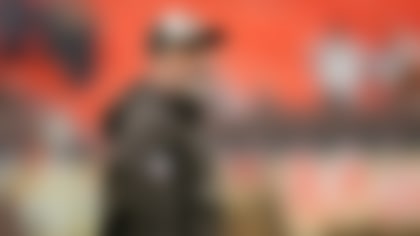A few months ago it was time to calm down the expectations surrounding the high picks for the 2010 NFL Draft at defensive tackle: Ndamukong Suh and Gerald McCoy.
Both players look like tremendous prospects. McCoy has said that his high-end expectations were to hopefully surpass the numbers posted by Warren Sapp in his rookie year. As a rookie in 1995, Sapp registered three sacks. Suh and McCoy are likely to be successful in the NFL, but not right away.
While expectations for Suh and McCoy are high, much also is expected from the top quarterbacks selected in the draft. Fans have to gain a realistic perspective on rookie quarterbacks who start right away.
There are four rookie quarterbacks who could see real game action in 2010.
» Colt McCoy will see limited action because the Cleveland Browns are close to announcing Jake Delhomme as the starting quarterback.
» Tim Tebow might play, but the Denver Broncos have indicated that Kyle Orton is the starter.
» Jimmy Clausen currently sits behind Matt Moore on the Carolina Panthers' depth chart.
» Sam Bradford, the first overall draft pick, is on the launch pad to start right away for the St. Louis Rams.
The Rams have sustained injuries on the offensive line this spring, as Mark Setterstrom has suffered a torn tricep, rookie Rodger Saffold is limping around with a knee sprain, and Jason Smith is dealing with a serious toe injury. With or without those injuries, Bradford has to be on the field sooner rather than later, and there are some realistic expectations that Rams fans should have for their rookie quarterback. Those sort of expectations should carry over to the fans in Carolina, Cleveland and Denver if the rookies there take the field.
The money down is third down, and here's a look at 13 rookie quarterbacks thrown into the action early and how they faired in the most difficult situation during a game. These 13 quarterbacks were put on the field with the philosophy of learning by doing, not by watching. If one of the four 2010 rookie quarterbacks takes the field, here's a look at realistic expectations for third-down performance.
All of these quarterbacks were thrown on to the field for significant playing time in their first season. Based on those 13 recent rookie quarterbacks, some have gone on to greatness while others left the league early. Still, third-down looks like a real struggle. The 2010 rookies who play right away should expect to throw more interceptions than touchdowns on third down, and also be sacked once every 12 third-down attempts.
There are some other interesting areas to look at, and the rookie QB class of 2009 (Freeman, Sanchez and Stafford) helps provide some clues about what to expect from this year's rookie QB class.
Stafford's first-quarter passing indicates that time may be the best to let a rookie quarterback come out throwing the ball. Stafford completed 53 of 86 passes for 690 yards, seven touchdowns, two itnerceptions and just two sacks in the first quarter. Those seven touchdown passes were better than what Tony Romo, Tom Brady and Eli Manning produced in the first quarter.
As you might expect, when it comes down to fourth-quarter passing the rookie quarterbacks struggle. It is actually worse than you might imagine when based on last season's rookies.
As one college scouting director told me when we discussed these results, "Freeman has a chance to be a pretty good player; better than I thought."
The point here is that a 2010 rookie quarterback should be expected to produce close to a 50 percent completion rate, at least three times as many interceptions as touchdowns, and get sacked once every 18 attempts.
A very interesting result surfaced when looking at last year's rookie quarterbacks vs. the blitz as compared to non-blitz situations. On the surface, you would expect defenses to go after rookie quarterbacks and have excellent results. First, all three youngsters saw more coverage calls than blitz calls. In fact, it worked out to be 63 percent coverage calls and 37 percent blitz calls. The results indicate Stafford and Sanchez were more productive against the pressure calls than the coverage calls. Freeman was slightly better against the coverage calls than the pressure calls, but as a group last year's rookie quarterbacks had three more interceptions per attempt (one every 18 passes) against coverage than against the blitz (one interception every 21 pass attempts).
Bradford seems like a quarterback who will see the blitz and know what to do with the ball. His challenge might come when the defense plays coverage and forces him to stick the ball in very tight places.
I looked at the three young quarterbacks in the shotgun formation vs. being under center to see how they performed. Most young quarterbacks are coming out of college with a lot of shotgun experience, but then it boils down to who does the shotgun help more, a young quarterback or the defense? Stafford was in the shotgun almost twice as much as he was under center, and Sanchez was just the opposite with close to twice as many throws from under center than in the shotgun formation. Both quarterbacks had a better rating under center than they did out of the shotgun. As for Freeman, he threw from the gun much more than from under center and was more successful in the shotgun. One former NFL head coach with expertise in coaching quarterbacks thought that Bradford would be much better off under center with Steven Jackson behind him threatening the run.
All three rookie quarterbacks relied on their tight end more than the average NFL starter, which reinforces the old adage that a rookie quarterback's best friend is his tight end. The average NFL quarterback is going to complete passes to his tight end about 22 percent of the time, but these rookie quarterbacks as a group completed 30 percent of their passes to tight ends. Will Bradford have the go-to tight end such as Kellen Winslow, Dustin Keller and Brandon Pettigrew (even though he got hurt) that the 2009 rookie quarterbacks had?
No matter which 2010 rookie quarterback takes the field, please lower your expectations and give the young man some breathing room. Remember how McCoy knows Sapp's rookie season numbers? Well, keep in mind Peyton Manning's rookie numbers. He went 3-13 as a starter, threw more interceptions than touchdowns (22 to 28) and only completed 56.7 percent of his passes.



